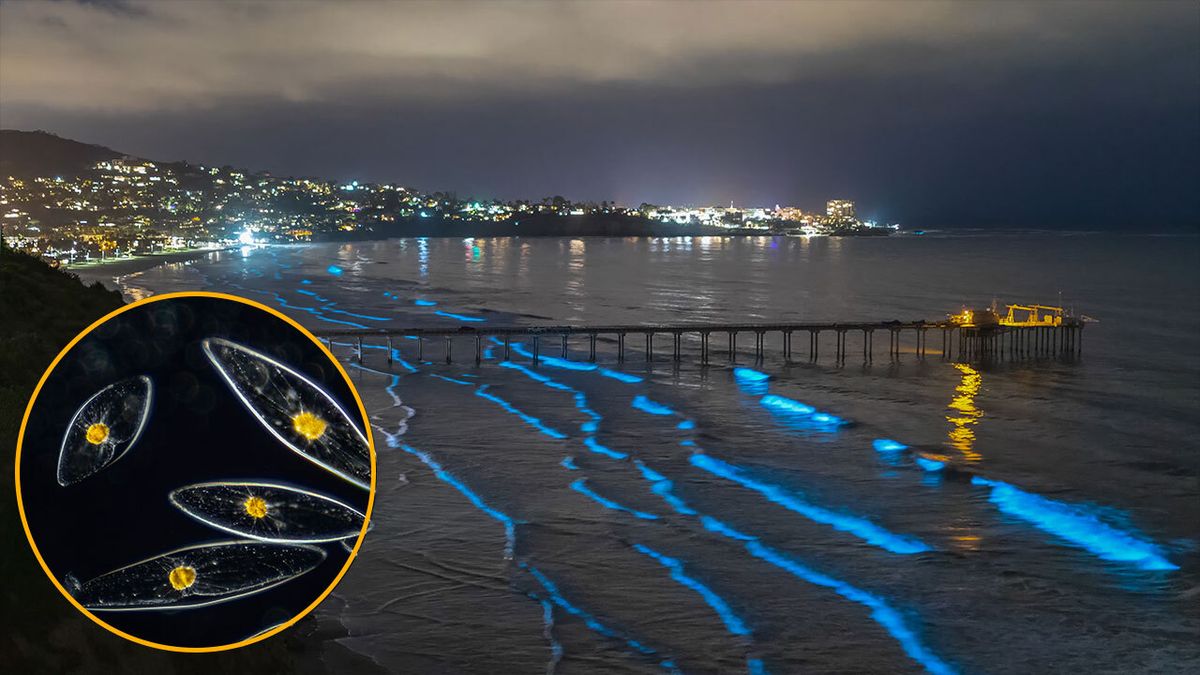Videographers have captured incredible footage of one of the largest tidal blooms of glowing algae ever recorded in Southern California.
The dazzling ocean light show, which appeared off the coast of San Diego, is featured in “San Diego: America’s Wildest City,” an episode from the Emmy and Peabody-winning PBS series “Nature.” The light show was produced by single-cell organisms called dinoflagellates, which produce an ethereal glow known as bioluminescence through an internal chemical reaction.
“When agitated by movement, the dinoflagellates emit bright blue light that startles would-be predators,” Nate Dappen, writer and director of the episode, told Live Science in an email. “When the numbers are high enough, every crashing wave glows blue as billions of cells bioluminesce at the same time in the churn of the surf.”
In the spring of 2020, San Diego experienced a period of heavy rainfall which led to a significant algal bloom. The rain settles on the ocean’s surface, forming a separate layer from the deeper water. This separation traps nutrients brought up by a storm near the surface, creating the perfect conditions for phytoplankton to thrive.
Researchers recorded the highest number of Lingulodinium polyedram at Scripps Pier in California, at approximately 2.4 million cells per gallon (9 million cells per liter), according to the Southern California Coastal Ocean Observing System. The high concentration of cells turned the sea a reddish brown during the day — known as a “red tide.”

“In 2020, San Diego saw the biggest red tide since 1900. It was unreal,” Dappen said. “For about a week the coast was exploding with light every night. That happened to also be the year that we started developing this show.”
Related: ‘The simplicity of life just hits you’: Watch rare footage of critically endangered eastern lowland gorilla feeding her baby in the wild
Satellite images show the phytoplankton bloom stretched from Los Angeles to Baja California, Mexico. But the phytoplanktons’ brightness is largely dependent on calm sea conditions, making ideal viewing hard to predict.
“Our team worked with two local talented filmmakers named Alex Nye and Patrick Coyne who spent many long nights on the coast searching for perfect conditions to film,” Dappen said.
The team also worked with wildlife filmmaker Alex Wiles to record bioluminescent algae under a microscope, which proved to be a challenge. “At that tiny scale, any movement made the footage too shaky,” Dappen said.
Even the slightest movement of the plankton would trigger bioluminescence but the cells appeared out of focus. “Luckily, Alex figured out a way to agitate them without moving them, by adding several substances to the water they were in,” Dappen said.
The episode also features extremely rare footage of San Diego’s other unique wildlife. “Across the show, we made many discoveries. In fact, several of the sequences were not planned,” including orcas (Orcinus orca) hunting dolphins and a glimpse at the new population of crows in San Diego, Dappen said.
“San Diego: America’s Wildest City” airs on PBS on Wednesday, Nov. 6. For times, check local listings. It will also be available at pbs.org/nature and the PBS app. Select episodes will be available to stream on the Nature YouTube channel.


